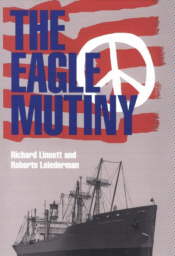 |
MUTINY ABOARD THE S.S. COLUMBIA EAGLE
A Book Review
From the January-February, 2002, issue of
The Master, Mate & Pilot
Official Voice of the
International Organization of Masters, Mates & Pilots
The Eagle Mutiny
by Richard Linnett and Roberto Loiderman
Reviewed by Capt. E. L. Sherrill
 |
On March 14, 1970, aboard the freighter COLUMBIA EAGLE of the
MM&P-contracted Columbia Steamship Co., two crew members pulled guns on the
Captain and ordered him to take the ship to Cambodia. Thus began the first
mutiny on board a U.S.-flag vessel in over 100 years. The mutineers - 26 year
old Fireman Clyde McKay and his 21 year old accomplice, B.R. Steward Alvin
Glatkowski - were seeking to divert the ship and her cargo of bombs and
ammunition as a protest against the Vietnam war. The Eagle Mutiny tells the
story of this incident which, along with the loss of the BADGER STATE and the
seizure of the MAYAGUEZ, is remembered as one of the most dramatic tales of the
Vietnam sealift.
The book chooses the point of view of the two mutineers
rather than of the real hero of the story, the EAGLE’s Master Capt. Donald O’Bannon
Swann. Although this seems a rather perverse choice at first, the mutineers were
probably the two most interesting characters in the story. Anyway, there have
been, and always will be, lots of captains, but in the U.S. Merchant Marine in
the twentieth century, only two mutineers.
As the story unfolds, however, with the mutineers producing pistols
and announcing they have the means on board to blow up ship and cargo, the
heroism of Capt. Swann becomes evident. Here he was faced with a situation not
covered on any license exam, and many years before the subject was treated in
any master mariners’ readiness course. The only cue he could take was from
pilots of hijacked airliners who were instructed to be cooperative and do
whatever was necessary to get aircraft, crew, and passengers safely on the
ground somewhere. Swann had an option not available to airline pilots, though.
He had lifeboats and he was able to get all nonessential crew members (on the
pretext of a bomb threat abandon ship drill) off in them and away from the ship.
With a skeleton crew of 13 plus the two mutineers, the
COLUMBIA EAGLE left the lifeboats and steamed off towards Cambodia. Capt. Swann
steered a circuitous course, giving U.S. Naval Forces plenty of opportunity to
recognize that something was wrong, and effect a rescue - an opportunity that
never was taken. They arrived off Sihanoukville the next afternoon, three days
before the coup by the pro-western Prime Minister, Lon Nol. The coup brought
Cambodia into the war on the side of South Vietnam and the United States, but it
was still almost three weeks before the EAGLE was allowed to leave. She
proceeded to Subic Bay where the crew who had abandoned ship at the start of the
mutiny rejoined her, and her cargo was discharged for delivery to Thailand by
another vessel.
That brought the voyage to a successful conclusion.
Capt. Swann had delivered the cargo to a discharge port, and the crew, in spite
of the baleful utterances and posturing by the mutineers, were all kept from
harm.
As for the two mutineers, McKay and Glatkowski, they
could best be characterized as being Influenced by troubled times. The demand
for ships and crews engendered by the Vietnam sealift brought a lot of persons
who could perhaps be best described as “colorful” Into the Merchant Marine.
Perhaps it was inevitable that a couple of mutineers would be there to round out
the mix. The accounts of McKay and Glatkowski's lives before the mutiny, though,
show patterns of irresponsible and erratic behavior. They also became swept up
in the rhetoric of the counterculture of those days - rhetoric that served to
encourage irresponsibility and indolence.
Ironically, after their arrival in Cambodia, their expected
welcome as heroes quickly turned into a cold aloofness, culminating in their
being thrown into prison. The final Irony was that, in trying to Impede the
American war effort in Vietnam, their actions resulted In a shipload of high
explosive weapons being brought to Cambodia on the eve of the pro-western coup.
Trying to aid the Viet Cong and their communist allies, they are remembered —
incorrectly, it turns Out, but remembered all the same - as being the ones who
delivered the weapons necessary to make the anticommunist coup succeed.
The Eagle Mutiny, ISBN 1557505225, was published in June 2001 by the Naval Institute Press. It is 304 pages including illustrations, hardbound, and has a list price of $32.95. The publisher’s jacket review reads, in part: “On March 14, 1970, two young crew members took over a tramp steamer carrying napalm to Thailand for the war in Vietnam, thus sparking the first armed mutiny aboard an American ship in 150 years.... After a tense Impasse with the U.S. military, the two men turned the ship over to Prince Sihanouk’s government, declared themselves anti-war revolutionaries, and were granted asylum. Two days later, however, a coup put pro-U.S. Lon Nol in power and the two were imprisoned. Sihanouk, now in exile, charged that the CIA had masterminded the mutiny to deliver weapons to Lon Nol, but the mutineers and U.S. officials denied his charges.”
The Master, Mate & Pilot, January-February, 2002
The Eagle Mutiny
by Richard Linnett and Roberto Loiderman
Reviewed by Capt. E.L. Sherrill